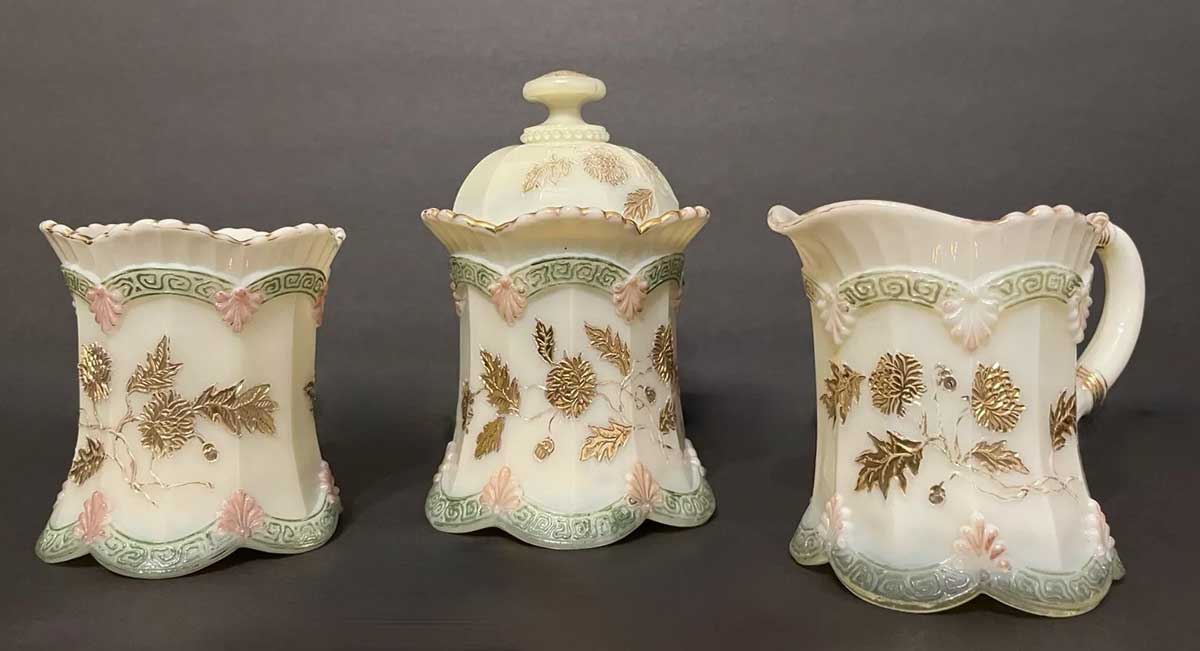October 2024
Good Eye
Feast your eyes on delicious antique custard glass
by Peggy Whiteneck
Custard glass is creamy ivory or pale-yellow pressed glass that was popular in the late 19th and very early 20th centuries. It was used in tableware made by some English and Czech/Bohemian companies but is generally found here in the U.S. made by American companies, including Dithridge, Northwood, Heisey, Jefferson Glass, and Fenton. Custard glass was made with elements including uranium and sulfur and will glow under blacklight. The oldest glass was unmarked and identified primarily by pattern though one will occasionally find a piece with the maker mark on the base.
The glass itself usually had molded designs of florals and borders that were painted. The painting has had variable longevity. The more a set was used, the more susceptible the paint would be to wear. In some cases, the paint has deteriorated to such an extent that it is better to remove it so that the underlying glass form can show to its best advantage.
The color accent on the oldest custard glass is a brown or green wash such as seen in Northwood and Fenton, and this has usually survived to better advantage than the more multi-colored painted varieties that came along just a bit later. Sometimes decoration on painted glass was done just in enameled gold paint.
One of the painted custard glass patterns that survives in best condition was Northwood’s Chrysanthemum Sprig. It was made in a variety of tableware and serving forms, of which I’ve been able to identify the following (though more forms may have been produced): pitcher and glasses, sugar and creamer, spooner, toothpick, round covered butter, jelly compote, and berry bowl set. The spooner and sugar are essentially the same size and shape, but the sugar bowl will have a rim on the inside to accommodate its fancy lid. Chrysanthemum Sprig was also made by Northwood in a blue glass, likewise painted, primarily in gold with green painting in the border whereas the custard versions also included pink accents in the borders.
Online prices for Chrysanthemum Sprig are mostly in the $50-$75 price range with a few going higher. Complete or near-complete sets of table centerpiece pieces will sell for more. Northwood also made custard glass in other patterns, including Argonaut, Fan and Feather and Grapes and Leaves.
It should be noted that the Chrysanthemum Sprig pattern has been imitated in at least the toothpick form. Northwood examples will have tops that are flared to the same diameter as the base. The top of the late-20th century copy by Summit Glass is pulled in narrower than the base.

(Left to right) Northwood Chrysanthemum Sprig spooner, sugar, and creamer. Items in this design will have varying degrees of paint loss. This set, offered for sale on eBay in September, is in exceptional condition, with most paint loss on the sugar cover. (Image courtesy of eBay)
Fenton made a lot of custard glass in 1976 and later, but, again, its first examples were much earlier in the 20th century (the teens) with a nutmeg or green wash that left the convex glass molding unwashed and clearly identifiable. Fenton custard glass patterns included Cherry and Scale, Blackberry Spray, Stalking Lion (Orange Tree on underside of bowls and plates), Bluebird, Persian Medallion, and others. Fenton also made a couple of patterns with multi-colored paint on custard glass, such as the red, white and blue Prayer Rug design made in a vase and a few table/serving pieces. Of these Fenton patterns, the most expensive on the secondary market is Cherry and Scale with a nutmeg wash. Individual glasses in that pattern are affordable, but the pitcher that goes with a set of six glasses could set you back more than $200, with the covered butter dish not far behind.
Finally, I should mention a line made in the mid-20th century — Anchor Hocking’s Fire King. Colors in this glass ranged from green to turquoise, but it also featured a color very close to custard glass that it called “Ivory.” Fire King’s simple forms included cereal bowls, mugs, mixing bowls, and other forms that remain abundant and affordable on the secondary market.
Whichever the maker, custard glass is a delicious feast for the eyes!
Peggy Whiteneck is a writer, collector, and dealer living in East Randolph, VT. If you would like to suggest a subject that she can address in her column, email her at allwritealready2000@gmail.com.

